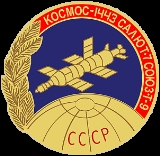
Soyuz T-10-1
Encyclopedia
Mission parameters
- Mass: 6850 kg
- Perigee: N/A
- Apogee: N/A
- Inclination: N/A
- Period: N/A
Mission highlights

Soyuz-U
The Soyuz-U launch vehicle is an improved version of the original Soyuz LV. Soyuz-U is part of the R-7 family of rockets based on the R-7 Semyorka missile. Members of this rocket family were designed by the TsSKB design bureau and constructed at the Progress Factory in Samara, Russia....
rocket and caught fire at T-90 seconds. The launch control team activated the escape system but the control cables had already burned, and the Soyuz crew could not activate or control the escape system themselves. Twenty seconds later, launch control was finally able to activate the escape system by radio command, by which time the booster was engulfed in flames. Explosive bolts fired to separate the descent module from the service module and the upper launch shroud
Shroud
Shroud usually refers to an item, such as a cloth, that covers or protects some other object. The term is most often used in reference to burial sheets, winding-cloths or winding-sheets, such as the famous Shroud of Turin or Tachrichim that Jews are dressed in for burial...
from the lower. Then the escape system motor fired, dragging the orbital module
Orbital module
The orbital module is a portion of spacecraft used only in orbit. These have developed from the Soviet Soyuz spacecraft.-Soyuz orbit module:The orbit module is a spherical part of Soviet-Russian Soyuz space ship series...
and descent module
Reentry capsule
A reentry capsule is the portion of a spacecraft which returns to Earth following a space flight. The shape is determined partly by aerodynamics; a capsule is aerodynamically stable falling blunt end first, which allows only the blunt end to require a heat shield for atmospheric reentry. Its shape...
, encased within the upper shroud, free of the booster with an acceleration of 14 to 17g (137 to 167 m/s²) for five seconds. Two seconds after the escape system activated, the booster rocket exploded, destroying the launch complex (which was, incidentally, the one used to launch Sputnik 1
Sputnik 1
Sputnik 1 ) was the first artificial satellite to be put into Earth's orbit. It was launched into an elliptical low Earth orbit by the Soviet Union on 4 October 1957. The unanticipated announcement of Sputnik 1s success precipitated the Sputnik crisis in the United States and ignited the Space...
and Vostok 1
Vostok 1
Vostok 1 was the first spaceflight in the Vostok program and the first human spaceflight in history. The Vostok 3KA spacecraft was launched on April 12, 1961. The flight took Yuri Gagarin, a cosmonaut from the Soviet Union, into space. The flight marked the first time that a human entered outer...
). Four paddle-shaped stabilizers on the outside of the shroud opened and the descent module separated from the orbital module at an altitude of 650 m, dropping free of the shroud. The descent module discarded its heat shield
Heat shield
A heat shield is designed to shield a substance from absorbing excessive heat from an outside source by either dissipating, reflecting or simply absorbing the heat...
, exposing the solid-fuel landing rockets
Solid rocket
A solid rocket or a solid-fuel rocket is a rocket engine that uses solid propellants . The earliest rockets were solid-fuel rockets powered by gunpowder; they were used by the Chinese in warfare as early as the 13th century and later by the Mongols, Arabs, and Indians.All rockets used some form of...
, and deployed a fast-opening emergency parachute. Landing occurred about four kilometers from the launch pad. The two crew members were badly bruised after the high acceleration, but had survived.
The failure's immediate result was the inability to replace the aging Soyuz T-9
Soyuz T-9
-Backup crew:-Mission parameters:*Mass: 6850 kg*Perigee: 201 km*Apogee: 229 km*Inclination: 51.6°*Period: 88.6 minutes-Mission highlights:4th expedition to Salyut 7...
return capsule attached to the Salyut 7 space station. This led to overblown reports in the Western media about the cosmonauts remaining aboard Salyut 7 (which had arrived several months before in the T-9) being 'stranded' in space, with no ability to return.
Years later, in an interview with the American History Channel regarding the flight, Titov claimed that the crew's first action after the escape rocket fired was to deactivate the spacecraft's cockpit voice recorder
Cockpit voice recorder
A cockpit voice recorder , often referred to as a "black box", is a flight recorder used to record the audio environment in the flight deck of an aircraft for the purpose of investigation of accidents and incidents...
because, as he put it, "We were swearing."
See also
- Soyuz 18aSoyuz 18aSoyuz 18a was a manned Soyuz spacecraft launched by the Soviet Union in 1975, intended to dock with the orbiting Salyut 4 space station, but which failed to achieve orbit due to a serious malfunction during launch...
, 1975 Soyuz launch failure - List of space disasters
- Description and history of Soyuz Escape System (Russian Spaceweb web page): http://www.russianspaceweb.com/soyuz_sas.html

